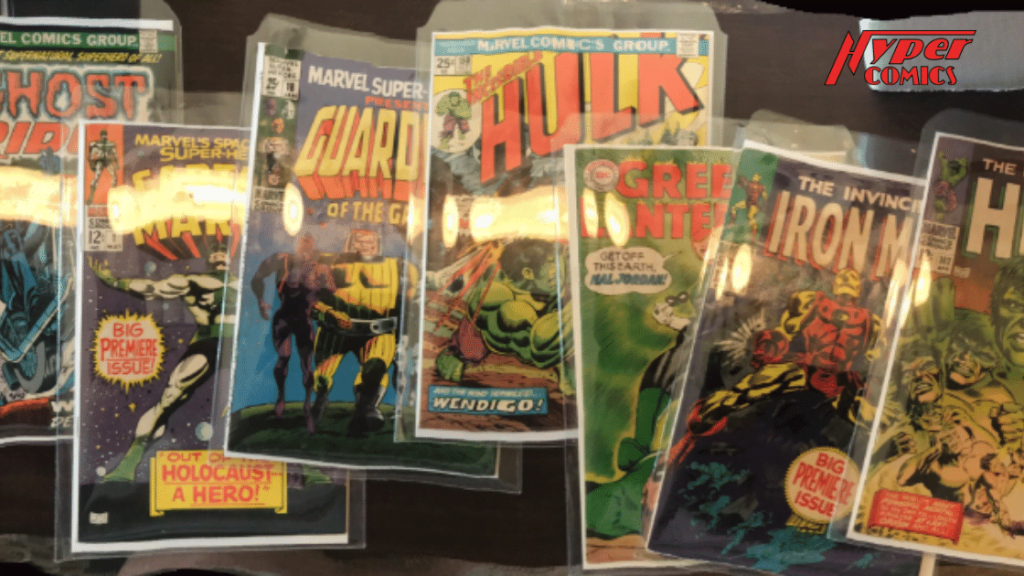
“I looked up this comic on eBay and found one copy for $5 and another for $50! Why? How do I know how much my comics are worth!”
- This is a question I am often asked and the answer, “it depends”, isn’t what you want to hear.
To determine a Fair Market Value (FMV), you need to know two things: 1) What comic it actually is and 2) what is it’s condition
Indentification
First lets identify the exact comic book you have, it’s not always clear. Characters, like Superman, Batman, Spider-Man, Thor, etc. are found on the cover of many books. Remember the publisher’s business is to sell as many comics as they can, so they crank out books with heroes like Spider-Man and Batman and sometimes you can’t easily tell what series it is by looking at the cover.
You need to look at the comic’s indicia, a information section from the publisher that lists the series, volume, issue, date and other legal details. The indicia is typically found on the 1st or last page of the comic.
Condition
Now that you know what you have, you need to consider its condition. This is the most important and least understood aspect of determining value. The condition refers to the structure of the book in it’s entirety. A comic in a bag that looks brand new may have pages missing, coupons cut or other problems that aren’t visible without close, careful inspection.
The process of determining a comic book’s condition is called grading. Common grade categories are:
- Poor
- Fair
- Good
- Very Good
- Fine
- Very Fine
- Near Mint
- Mint
These are further refined using a 0 to 10 numeric system, with 10 being the extremely rare perfect comic book. The comic book collecting industry was radically changed in the early 2000’s when third party grading was established by companies like Comic’s Guarantee Company (CGC) and Comic Book Certification Service (CBCS). This gave collectors piece of mind knowing that the expensive item they were purchasing from a dealer had been inspected, verified and a grade assigned. Historically grading was very subjective and varied from dealer to dealer.
Remember that comic books were initially created to be read by children. Printed on inexpensive paper, they were often folded, stacked, soiled, torn, marked, and taped by their young owners. High grade comics (Very Fine to Mint) are rare prior to the 1980’s. The rarity of older comics in high grade tends to make the valuable. For more information on grading comic books, see https://comicspriceguide.com/comic-book-grading.
Suffice to say that comics usually have many flaws that detract from its potential value. Here are a few:
- lines and folds on cover
- tears
- cover or centerfold separated
- pages missing or coupons cut out
- corners abraded or rounded
- tape
- date stamps or writing
- off-white, yellow or brown pages
All these things help to determine whether a collectible book will sell for $1 or $1,000 on eBay.
Then What Are My Old Comics Worth?
Now considering we know what we have and what condition is closest to, we can make take a look at sales data from buyers and get an idea of a comic books fair market value. There are several locations to get sales data, some paid, some free. Two websites that track the sales of third party professionaly graded comic books (frequently called “slabbed” comics) are GoCollect.com and GPAnalysis.com. Every month they track and report the sales of comic books from the major auction houses, providing a fair market value of sold books. These pay sites cost about $10 a month, although GoCollect does provide some useful information for free. Comics that are professionally graded by third parties have the most accurate FMVs.
You can also find sales date for ungraded comics, called “raw comics” from the website covrprice.com which has limited free data and paid options. Using these requires more familiarity with grading.
The most used site for free sales data is eBay, probably the largest marketplace for comics. Follow this process to get an idea of what a comic book is going for:
- Search for the specific issue
- Filter the results by clicking the word Advanced on the right of the Search button
- check the box for Sold Listing in the Search Including area – This gives you a list of sold comics (Note comics sell higher when they are professionally graded and are in grades 9.0 or higher)
Compare your comic books to pictures of recent sold listings to get a “ball park” estimate of your book. Now you are finally getting close!
A Final Word on Value
So you have found something that looks similar to your books and you think you are ready to sell them or at least brag to your friends about them. But…there is one more determination of value and that is from the buyer. Ultimately, the buyer has the final say on what your comic is worth. If you price too high for a book or incorrectly grade it, you will not sell the book, or have a dispute. It all depends on who your selling to and what market you go through, be it online auctions or a comic books show. And all collectors, dealers and investors want to haggle a discount, so be prepared for offers. Auction houses take a hefty cut too, either from the seller or the buyer, who then will bid a little less to cover fees.
In the end comic books are worth what the buyer pay or what you will accept. This introduction to comic book values should give you a good idea where to start investigating what you have.
If you are interested in selling or doing a consignment through to hypercomics, feel free to contact us below.
Best wishes and happy collecting!